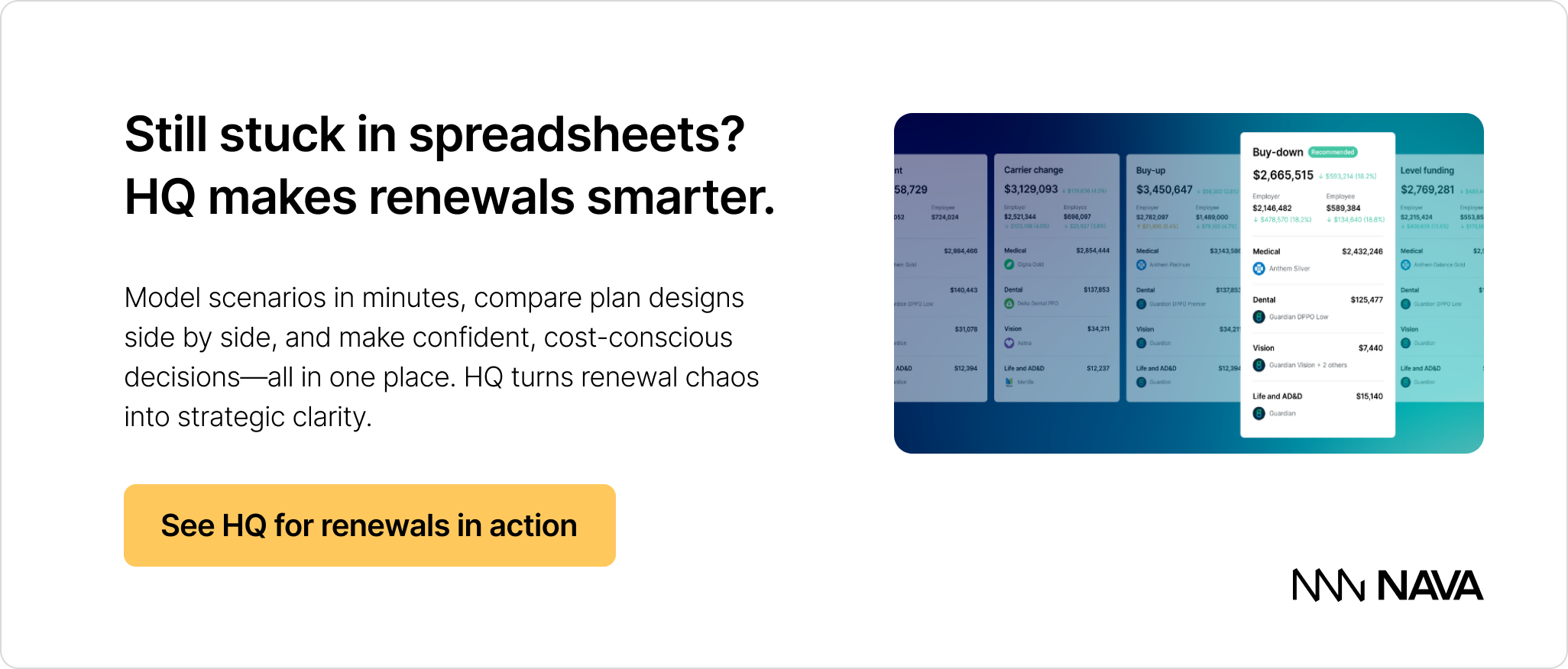Who to include in benefits renewal discussions (and why it matters)

Benefits renewal is a high-stakes, cross-functional effort that directly impacts cost, employee experience, and retention, so it shouldn't fall on HR alone. This guide outlines the must-have and supporting stakeholders to involve, what each brings to the table, and how to keep the process organized and on track. With the right team and structure, you can turn renewal season into a strategic advantage for your business and your people.
Benefits renewal is one of the most high-stakes moments in the employee benefits lifecycle, and it’s no longer something HR should be tackling alone. The decisions you make during renewal directly shape your company’s cost structure, employee experience, and ability to attract and retain top talent.
As the scope of employee benefits expands, so does the need for diverse perspectives in the renewal process. Involving the right stakeholders early and consistently not only strengthens your decisions, it ensures alignment across leadership and increases buy-in where it counts most.
In this post, we’ll walk through who should be part of your benefits renewal team, what value each stakeholder adds, and how to manage the process effectively from start to finish.
Who are the must-have players in a successful benefits renewal?
These individuals should always be at the table for benefits renewal planning and decision-making because everyone comes to the table with different priorities. Finance wants to make fiscally responsible choices. HR is focused on supporting and retaining talent. People managers may be thinking about performance-driven incentives, while leadership is weighing long-term business goals. And employees? They just want to feel seen, supported, and covered.
Renewal season is where all of these perspectives converge. The best outcomes come when you align early, clarify goals, and design a plan that reflects both your business strategy and your people’s needs. Bringing the right stakeholders into the conversation upfront helps avoid misalignment down the line and sets the stage for smarter, more confident decisions.
HR / People leader(s)
Your HR or People team typically owns the benefits function. They understand employee needs, manage vendor relationships, and are responsible for plan communication and execution.
Role:
- Coordinate input from across the business, including internal and external partners
- Evaluate plan options and trade-offs
- Lead communication before, during, and after open enrollment
Finance leader (CFO or Controller)
Your finance partner plays a critical role in aligning benefits decisions with your company’s financial strategy and long-term planning.
Role:
- Assess ROI and total cost of ownership
- Evaluate budget impacts, funding strategies, and employee contribution models
- Align renewal strategy with overall company goals
Executive sponsor (CEO, COO, or Chief People Officer)
An executive-level sponsor ensures that your renewal strategy reflects the organization’s values, growth priorities, and risk tolerance.
Role:
- Provide strategic direction
- Support cross-functional alignment
- Sign off on major plan design or vendor changes
Benefits broker or consultant
Your benefits broker isn’t just there to negotiate rates — they should function as a true consultant.
A great broker is your strategic partner in designing, modeling, and communicating your renewal plan. They should bring creative funding strategies to the table, help you understand how your offering compares to market benchmarks, and support your employees through the complexities of open enrollment and beyond.
Role:
- Bring market benchmarks and cost-saving strategies
- Manage carrier communications and renewals timeline
- Support project management and employee education

Who are the supporting stakeholders that can strengthen your benefits renewal?
While not always in the driver’s seat, these secondary stakeholders can significantly enhance the quality and inclusivity of your renewal plan. Research shows that stakeholder diversity fosters more comprehensive decision‑making by surfacing new insights and reducing blind spots.
Moreover, organizations that engage influential voices beyond core decision‑makers are more likely to succeed. In transformation efforts, initiatives involving trusted, influential employees are four times more likely to succeed.
DEI or culture leader
Benefits are a tangible extension of company values. Including a DEI or culture leader ensures your plan design supports equity and reflects the needs of your diverse workforce.
Role:
- Identify gaps in coverage or access
- Recommend inclusive benefits that meet the evolving needs of your workforce
- Help communicate changes in a culturally competent way
Legal/compliance advisor
Navigating benefits compliance, from ACA and ERISA to PCORI fees and COBRA rules, requires specialized knowledge and up-to-date guidance. Whether that expertise comes from your internal team, a trusted benefits advisor, or another compliance partner, staying aligned with evolving regulations is essential.
Role:
- Review changes for regulatory compliance
- Reduce legal risk for plan sponsors
- Provide guidance on new legislation or policy updates
People managers or employee resource group (ERG) reps
Managers and employee resource groups (ERGs) have a front-row seat to what employees are struggling with or asking for. Managers often hear about day-to-day frustrations and benefits gaps before they reach HR, while ERGs surface needs tied to identity, inclusion, and culture.
Role:
- Offer feedback on benefits usability and awareness
- Highlight gaps or blind spots in plan design
- Advocate for specific needs (e.g., caregiving support, financial wellness)
Note: To avoid overcomplicating the process, consider inviting one or two trusted voices rather than a committee.
IT or operations lead
If you're changing platforms, integrating with a new vendor, or updating your payroll or HRIS systems, bring in your IT or ops lead early. Their involvement is crucial not only for technical feasibility but also for safeguarding sensitive employee data.
Role:
- Evaluate feasibility and integration timelines
- Ensure a smooth tech and data transition
- Vet vendors for data security standards, including HIPAA compliance and SOC 2 certification
- Identify risks around PHI handling, system access controls, and data encryption
How do you keep a cross-functional renewal process on track?
When your benefits renewal spans HR, Finance, IT, Legal, and other stakeholders, it’s easy for the process to stall without strong coordination. Keeping everyone aligned and moving in the same direction requires structure, clarity, and discipline, without turning every step into a group decision.
Here’s how to keep the process focused and productive:
- Assign a project lead. Typically someone in HR, this person owns the timeline, agendas, and follow-ups. They serve as the point of coordination, not just scheduling meetings but also driving the process forward.
- Establish a meeting cadence. Start early and set regular check-ins to review data, finalize decisions, and prepare communications. This helps ensure key conversations don’t pile up at the last minute.
- Use shared tools. A centralized tracker or shared document gives all stakeholders visibility into progress, responsibilities, and next steps. It also helps reduce confusion and unnecessary back-and-forth.
- Clarify decision roles. Define early who gives input, who reviews, and who makes the final call. This keeps the process collaborative without turning every step into a group decision. Not every stakeholder needs to weigh in on every detail.
- Streamline touchpoints. Consider breaking your renewal into key phases, such as modeling, communications, and tech integration, and involve the right people at the right time.
- Dial in your communication channels. Set up a dedicated Slack channel, email thread, or shared chat to centralize updates, questions, and quick decisions. This keeps conversations visible and reduces the risk of misalignment across teams.
What happens when you get the right people involved?
The best renewal strategies are built on strong collaboration. By assembling the right internal team and tapping into your broker’s full range of support, you’ll make smarter decisions, avoid fire drills, and deliver a benefits program that truly serves your people and your business.
No matter where you are in your renewal cycle, Nava is here to support you year-round with tools, modeling, and strategic guidance. Need help aligning your team or kicking off the process? Just reach out—we’re here to help.
.webp)






